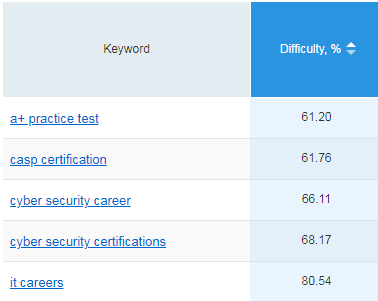Prioritizing and organizing search opportunities is perhaps the most difficult part of SEO keyword research.
Keyword grouping represents the last, and most important, portion of keyword research. If you identify all of the terms and phrases that are important to your business, but target sub-optimal opportunities, you won’t achieve the results you want.

Now that I’ve built a list of seed keywords and performed keyword analysis to identify potential opportunities, I need to prioritize those opportunities. Since I did all the work of analyzing keywords for CompTIA, I’ll continue to use them as my running example by prioritizing the terms I’ve identified.
For quick review, here are the seed keywords I’ll be working with (SV =search volume):
- [a+ certification] SV: 22,200
- [security certification] SV:8,100
- [casp certification] SV: 1,600
- [network certification] SV: 3,600
- [it certifications] SV: 8,100
- [cyber security certifications] SV: 8,100
- [cyber security jobs] SV: 14,800
- [information technology jobs] SV: 8,100
- [cyber security training] SV: 5,400
- [it careers] SV: 4,400
- [it training] SV: 2,900
- [a+ practice test] SV: 2,900
- [cyber security career] SV: 2,900
As part of my preliminary SEO keyword research, I’ve also analyzed these terms in regards to the following areas:
- Searcher intent.
- Search volume.
- Competition.
- SERP features.
- Ranking pages.
I’ll review my findings and compile them to identify the best opportunities, and then prioritize those terms for my SEO campaign.
1. Start with Business Goals
The first place you should start when prioritizing keyword targets is with your company’s goals.
If you’re not working toward defined SEO goals you’re wasting time and effort. This point is especially important for outside vendors or agencies, who should always be considering how their efforts support overarching client goals.

Obviously I can’t know exactly what CompTIA’s SEO goals are. However, I can guess that increased traffic to their converting pages would be one of them. Hypothetically, their certifications and exams would be top priorities. Some of the keywords associated with these pages have already been identified during my analysis, including:
- [a+ certification]
- [security certification]
- [casp certification]
- [network certification]
- [it certifications]
- [cyber security certifications]
- [it training]
- [a+ practice test]
- Etc.
For the purpose of this post we’ll assume that CompTIA’s practice test questions are a great lead generator and they have marked this page as high-priority:

With the goal of driving qualified traffic to this page in mind, [a+ practice test] would be a high-priority keyword. Also, considering CompTIA is already ranking in position 11 (according to SEMrush), it might not take much for them to move up towards the top of page one.
Two simple tweaks they could make to better optimize this page would be to:
- Add the term “A+” to their title: “Practice Test Questions”=>”A+ Practice Test Questions”.
- Expand the copy out further to explain what’s in the test and include a few example questions.
Through my keyword research I’ve identified a high-opportunity term that aligns with CompTIA’s business goals and would take little investment to positively impact. This should definitely be a high-priority keyword.
2. Balancing Difficulty and Opportunity
After making sure your top keyword targets align with your goals, you can prioritize by analyzing difficulty and opportunity.
Ideal keyword targets will have low difficulty and high opportunity. Keyword difficulty of course refers to competition, or how hard it theoretically would be to rank for a given term. These difficulty scores are determined by various keyword tools.
Reviewing my keywords for CompTIA, I pulled out the following terms as having low aggregate difficulty scores:
- [a+ practice test]
- [casp certification]
- [cyber security certifications]
- [cyber security career]
- [it careers]
These scores are according to Ahrefs:

Moz:

And SEMrush:

To measure potential opportunity I examine search volume — the more people searching for a terms translates directly to more opportunity to capture traffic. SEMrush provides a fairly accurate estimation of monthly search volume for any given keyword.

And these are the terms with larger search volumes and opportunity for ranking improvement:
- [cyber security certifications] SV: 8,100
- [information technology jobs] SV: 8,100
- [cyber security training] SV: 5,400
- [it careers] SV: 4,400
- [it training] SV: 2,900
- [a+ practice test] SV: 2,900
Comparing these two lists I can quickly pull out a few opportunities where low difficulty coincides with high search volume:
- [a+ practice test]
- [cyber security certifications]
- [it careers]
These terms should be prioritized in any content creation, onpage optimization, and link building as they offer the best opportunity for moving the needle. Furthermore, from my previous research I know that CompTIA is ranking just off page one (11-12 range) for these terms which means minimal effort could provide huge returns.
3. Consider Available Resources
Finally, you need to consider your available resources and what it might take to realistically rank a page for a given set of keywords.
Evaluating difficulty and search volume will highlight prime opportunities, but your SEO research isn’t finished. To prioritize these opportunities even further you need to consider what is required to actually execute on these opportunities. Ask yourself questions such as:
- How far off is my current page ranking from page one?
- Do I need to create an entirely new page? What type of page do I need?
- What would my optimization timeline look like? Days? Months? Years?
- Do I need to tweak onpage elements? Secure more links? Both?
- What resources or departments will be needed (designers, copywriters, web developers, etc.)?
The answers to these questions will provide a better picture of the resource and time investment required to effectively pursue an opportunity.
In terms of my CompTIA example, I’ll go back to the term [a+ practice test] since this term has a nice balance of low difficulty and high search volume. Asking these same questions within the context of CompTIA would solidify (or negate) this term as high-priority.
How far off is my current page ranking from page one?
CompTIA’s page is already competitive, ranking just off page one (position 11). This means slight tweaks to optimization or perhaps a handful of strong links could be all that’s needed to move the page onto the first SERP.
Do I need to create an entirely new page? What type of page do I need?
CompTIA already has a strong term that serves this query, so there’s no need to create a page from scratch.
What would my optimization timeline look like? Days? Months? Years?
Since CompTIA’s page is already ranking on page two, the timeline for achieving page one rankings shouldn’t be longer than a month or two — if the proper onpage changes are made and links are secured.
Do I need to tweak onpage elements? Secure more links? Both?
Yes and yes. I would recommend tackling both simultaneously.
The current page isn’t highly linkable and link acquisition could start slow. But, optimizing the page with more content and better formatting would improve link-worthiness as well.
What resources or departments will be needed (designers, copywriters, web developers, etc.)?
Depending on how CompTIA is structured, optimizing CompTIA’s existing page would require involvement from designers, web developers, and copywriters. This demonstrates how even small tweaks can quickly become convoluted, and this issue grows exponentially with larger projects.
After answering these questions I know for sure that [a+ practice test] is indeed a prime opportunity and should be prioritized as such.
Finding the path of least resistance is typically a solid strategy in any aspect of business. For large companies where bureaucracy can come into play, prioritizing quicker wins that require less resource investment can be crucial to proving SEO efficacy.

Target the easiest keyword opportunities first, and level up from there. An ideal SEO campaign targets quick, low-investment opportunities and long-term, higher investment opportunities simultaneously.
Review
Once you’ve done all the preliminary research of building a list of seed keywords and analyzing those terms, prioritizing keyword opportunities is rather straightforward. The primary criteria you should use to rank opportunities are as follows:
- Start with opportunities that most closely align with your goals.
- Target low difficulty, high volume terms.
- Consider resource investment and choose path of least resistance.
Using these criteria you can prioritize your keywords and group them into high, medium, or low priority.
Any successful SEO strategy is built on strong keyword research. Sufficient research helps you uncover opportunities you would otherwise miss and ensure you’re working efficiently. This research also informs your content strategy, empowering you to create content that your visitors and search engines value.
Don’t work blindly — identify, analyze, and prioritize your SEO keywords.
Bonus Tip: Use Competitors for a Shortcut
All of the research and analysis I’ve outlined during this series on SEO keyword research is important and necessary for long-term SEO success.
However, since you’ve stuck with me throughout these 4,000+ words I’ll give you one more bonus strategy that can shortcut some of this legwork for some quick opportunities. Of course, if you want to sustain an ongoing, enduring SEO campaign (assuming you intend to be in business for a long time) you’ll need to conduct the required research.
The trick to this shortcut is using your competitors to find lucrative keyword opportunities. Since your competitors share an audience with you, the keywords driving traffic to their sites are likely to be relevant opportunities for your site as well.
So how do you find your competitors’ important keywords? Simple: use SEMrush.
Read Cory Collins’ post about using SEMrush for keyword research to learn more about this strategy.

